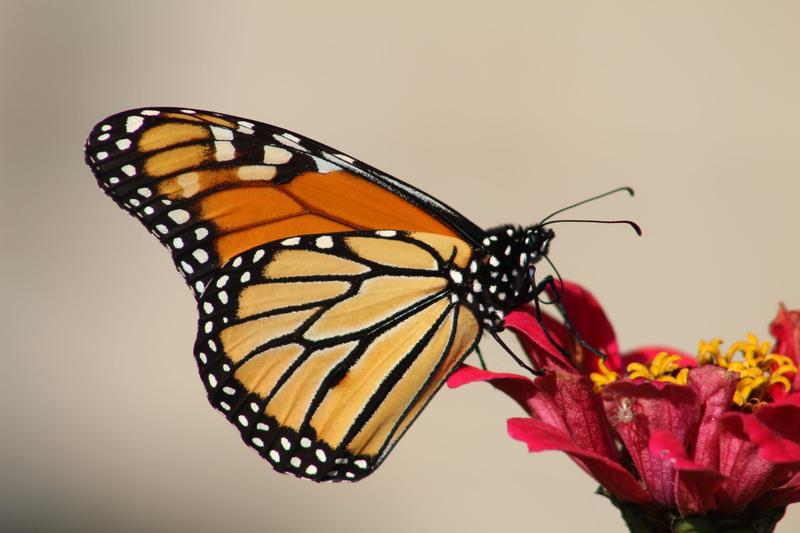Around October every year, a great orange migration of monarch butterflies moves from all over the United States east of the Rocky Mountains to the oyamel fir forests in central Mexico. Arrianne Byrum, public programs coordinator for the Woodlands Nature Station at Land Between the Lakes, visits Sounds Good to discuss this vividly colored species and how to witness their annual journey southward.

Although the monarch’s bright orange wings can easily be mistaken with Kentucky’s state butterfly, the Viceroy, it’s not entirely uncommon to see a true monarch in western Kentucky. “Ideally, monarchs are around, but it’s this time of year where you’re going to start seeing them moving South for the winter, which is really amazing,”
Byrum explains. “They’re making this amazing trip all the way — it’s like 3,000 miles in some cases – to central Mexico to the oyamel fir forests, and those butterflies have never seen those forests before. They’re actually fourth generation butterflies, so they actually make that journey having never, ever been there before.”
The “blind” nature of this 3,000-mile trek is “pretty unique to the monarch,” Byrum says.
“There are a number of migrating insects, but what makes monarchs so special is that they all do it at the same time. Historically, they end up kind of gathering in one location. There are places in Texas, actually, where you can see them flying overhead almost like flocks of birds. There’s pictures in the oyamel forests where it looks like the trees have been dusted with Cheetos because there’s so many monarchs on them.”
To get a better idea of the monarch butterfly’s migratory route, and how they navigate to a place never before seen by their generation, Byrum begins in the oyamel forests. “Overwinter, it’s a little warmer [in the oyamel forests]. It’s still pretty cool for them, but they can make it through the winter there. Those butterflies that have made that journey to the forest, they’re going to overwinter there, and they’ll live about nine months or so, which is the longest lifespan.
Usually, they’ll live about a month or so. After they overwinter, those same butterflies that made that long trip are going to start moving North a little bit. They’re going to move North, they’re going to breed, they’ll lay their eggs, and then they die. Those eggs hatch, turn into caterpillars, turn into butterflies, then they move further North. They do this three more times until that fourth generation moves all the way South again.”
“The way scientists are starting to think about it is that it’s a combination of a couple different things. Some of it could be genetic, but also, they use the sun as a big telltale to know what direction they’re going,” Byrum explains.
“Scientists figured out they can actually, in a way, tell time. The sun moves across the sky…so depending on where the sun is, south is different.
They actually ended up finding out that the butterflies’ internal clock is in their antennae somewhere. [Scientists] covered the antennae with paint, and [the butterflies] couldn’t tell time anymore, so they didn’t know which direction to go. They lost their sense of that. There’s talk about them feeling magnetic fields. That, I’m not super familiar with. But those are the two big hypotheses they have on how those butterflies are finding their way South having never made that trip before.”
The monarchs’ annual migration provides the western Kentucky area with the opportunity to witness a portion of their trek as they rest in Land Between the Lakes. Monarch butterflies are a fairly large butterfly, roughly hand-sized. Monarchs’ wings are bright orange with black striping and white spots. They are also one of the few species that can be easily distinguished as male or female — male monarchs sport two, highly visible, black spots — their pheromone glands – on the undersides of their wings. From a distance, it’s slightly difficult to correctly identify a monarch from a viceroy, Kentucky’s state butterfly. However, viceroys are typically smaller and have a horizontal black line across their hind wings, whereas the monarchs do not.
For the best chances of seeing a monarch butterfly, start with the milkweed plant.
“[Monarchs] rely solely on milkweed to reproduce. That is their host plant. A lot of butterflies, caterpillars, they all have host plants. Some of them, especially our more local, less traveled guys, they might have four or five host plants. But monarchs live off of milkweed only,” Byrum says.
“They can only lay their eggs on milkweed, they can only eat milkweed as caterpillars, because that’s what lends them to be poisonous, essentially, and not taste so good as caterpillars and butterflies. That’s something really crucial to their natural history and sort of behavior … they need that milkweed.”
“Viewing [the butterflies] at Land Between the Lakes is just a matter of going. Our backyard at the Nature Station, of course, is full of native plants. That’s going to be the big thing. If you want to see monarchs, you want to see native insects, butterflies, birds … planting native plants is a great way to do that, and we’ve got great demonstrations at the Nature Station regarding that. Also if you drive the Trace [the Woodlands Trace National Scenic Byway] you’re going to see milkweed and all sorts of cool other stuff. I saw Joe-Pye weed just full of butterflies the other day,” says Byrum.
Planting native milkweed can facilitate a healthy monarch environment in your backyard, but there are some varieties of milkweed that can be more harmful than helpful. “There’s a few different kinds of milkweed, so if you don’t like the sort of sterotypical, common milkweed, there’s also swamp milkweed. That’s a little more dainty, but just as pretty. A lot of people know about butterfly milkweed — it’s the orange one that’s really, really flashy. People like to put that one in their gardens.
These are milkweeds that the butterflies can use. So it provides nectar for all the critters, but also provides the habitat for [monarch] eggs,” Byrum explains. “The one thing we don’t recommend is planting tropical milkweed. The tropical milkweed is a non-native plant, and it blooms far longer than it would in this area [for] milkweed naturally. So it can lend to butterflies to kind of sticking around. In South Florida, for example, there are some non-migratory butterflies that stay there because the flowers are blooming and there’s tropical milkweed down there. Because of that, they have seen increases in parasites and whatnot in those particular populations because they don’t move around quite as much.”
Butterflies are significant and fascinating to people for a myriad of reasons. “[For] a lot of people, butterflies can be symbolic to them in a lot of ways, so some of it’s that. Some of it’s just a fascination with — especially if they’re chasing a monarch — they’re a well-traveled animal. That’s amazing, especially because that trip is something they’ve never done before. It’s a wonder of the world almost. It just doesn’t happen anywhere else. So it’s kind of neat to witness a small part of that. Since they’re not as concentrated here, it’s a little different, but people still really enjoy seeing them,” Byrum concludes.
(This report first ran on WKMS.org.)





